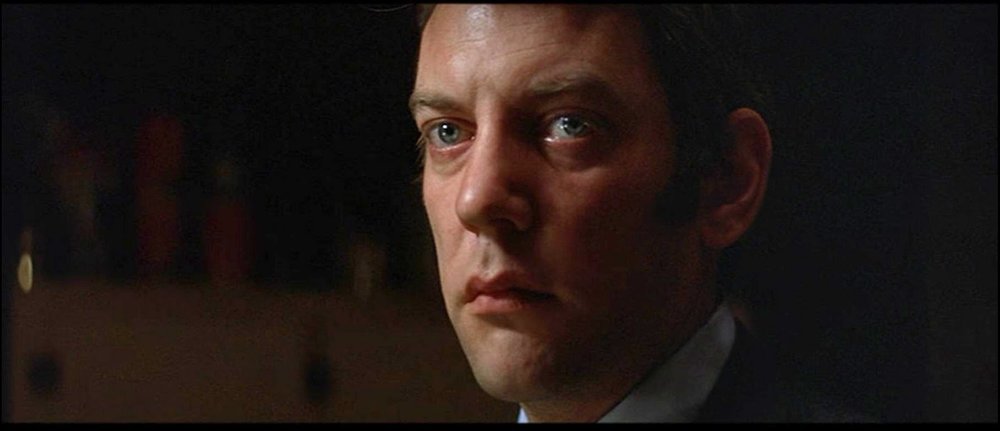Critical Cinema - Spotlight: Wexler & Willis
Posted on Thursday, December 21, 2017 at 05:00 PM

Haskell Wexler
Spotlight: Wexler & Willis
Critical Analysis by Critical Cinema X CalgaryMovies.com
Board member and programmer, Felicia Glatz explores the style and form of a true Auteur, via the works of Gordon Willis and Haskell Wexler.
FOR THIS SEASON’S SPOTLIGHT SERIES, WE ARE TAKING A TWO-FOLD DEPARTURE FROM OUR NORMAL FORMAT, THAT IS, WE ARE INCORPORATING TWO FIGURES INTO A SERIES DEDICATED TO THE ART CINEMATOGRAPHY.
Unable to choose between two Americans respectively decorated as legendary contributors to the American cinema landscape, we’ve combined their works into a politically charged and visually compelling collection from the 1960s and the 1970s.
We begin with three films by Haskell Wexler, Mike Nichols’ 1966 adaptation Who’s Afraid of Virginia Woolf?, Norman Jewison’s 1967 intense racial crime-drama In the Heat of the Night, and finally Wexler’s own 1969 Medium Cool.
Followed by three films embodying Gordon Willis’ philosophy of simplicity; never adding more when less could be better. Spanning multiple genres, this series is dominated by his work on the political films of Alan J. Pakula, All the President’s Men from 1976, The Parallax View from 1974, and finally, Klute from 1971.
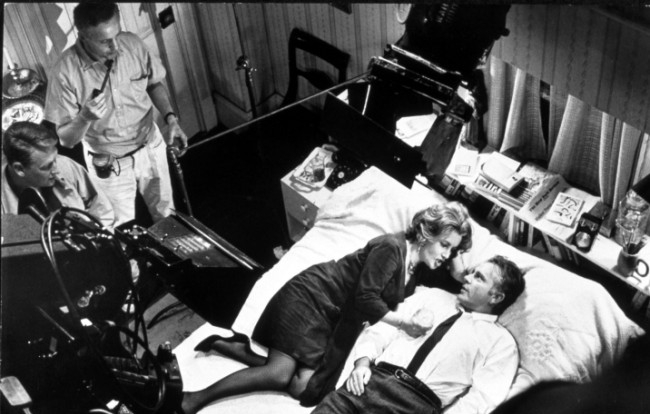
"Who's Afraid of Virginia Woolf? (1966)"
Both artists imbue distinct stylistic and formal mastery into their work, each informed by his own acute sense of political responsibility and further, his own sense of visual articulation. With this collection, we delve into the multivariate world of light, shading, and complex lens work that make up Wexler’s visual index. Along with an impressive inventory of ingenious and often spontaneously rigged camera apparati, his expressive angles and sometimes acrobatic camera lens personify his own vitality in spirit and social engagement. Then our second trio of films demonstrates Gordon Willis’ orientation toward shadow, often allowing it to predominate a frame. An approach that earned him the title “Prince of Darkness,” it became the texture that many directors sought after.
Cinematography, being the complex synthesis of exposure, camera angle, framing, aspect ratio, distance, depth of field, color, aperture, and movement, is a testament to the wholehearted investment that a director of photography must make to any project. The intricacy and timelessness of that union between artistry and technical prowess showcased in these films is itself the reasoning for their place in Calgary Cinémathèque’s 2017-2018 season. At a time when the majority of our attention is thrust toward the United States government, its leadership, and the reactionary movements birthed from the non-exclusive but taught racial, social, and economic atmospheres, films that invite, suggest, and powerfully depict resistance, exposure, and social justice become helpful and even cathartic. Films that propose an alternative way of looking, understanding, and confronting a prescribed way of living, being, and communicating. In their own ways, Willis and Wexler re-iterate an opaque cultural narrative of 1960s and 1970s America. Comprehensively this collection expresses a somewhat panoramic view of domesticity, the socio-economic and political temperatures, as well as the public unrest during a time in United States history when a shift in attitude and ambient suspicion penetrated all realms of American life.
Haskell Wexler
Possibly one of the most influential, inventive, and dedicated cinematographers, Wexler was a career crusader in the name of equality and social justice. His far reaching and plethoric catalogue of projects and investments alone speak volumes about his culturally attuned concern with “the morality of product,” and his tenacity toward political accountability. His activism took many forms, from infusing projects financially (i.e. to the sum of $800,000 for Medium Cool in 1969, then Latino in 1985), to embarking upon interviews with then fugitive terrorist leaders of the “Weather Underground,” amassing the erroneous attention of the FBI.
Indeed, Wexler had an indelible effect on the artistry considered in Cinematography, as well as the socio-political terrain within which he carved out spaces for instrumental dialogue. On many occasions grabbing issues by the jugular and laying them out for the world to see, employing his dexterity as a seasoned social documentarian to unearth and expose with an utmost moral agenda. He famously claimed, “One person has a responsibility not just for himself but for inter-relationships with the existences of others and the world,” the big picture forever ordaining the big screen.
A two time Oscar winner, and an honoree for lifetime achievement by the American Society for Cinematographers, the Independent Documentary Association, and the Society of Operating Cameramen, he was an active elect of the film community up until his death at 93 years of age. Appropriately dubbed a revolutionary, Wexler’s style is often considered ahead of its time while graciously nodding to the style and potency of Godard’s new wave filmmaking and the Italian neo-realists. His work is cumulative, informed, and ever compelling.
Our focus, is his ability to expressively agitate political issues in the name of social change through his use of moving photography. Innovative and stylistically distinct, Wexler’s work often shattered held norms about Hollywood cinematography; not only in terms of technique, but more so the meaning and context embedded in his informality.
Emerging largely from educational and industrial filmmaking after his time spent as a sailor in the War, Wexler drew from a visually minimalist inheritance. Relying heavily upon subtle lighting and a comprehensive grey scale, he toyed with the reflective properties and trajectory of light to effectively compartmentalize aspects of image, lending to either sharp, poignant political themes or to the soft illumination of human desire and emotion.
.jpg?format=2500w)
"In the Heat of the Night (1967)"
Wexler was brought on to work on Who’s Afraid of Virginia Woolf? rather late in the project, Harry Straddling had laid the ground work for the Photography but ultimately refused to film the picture in Black and White. Armed with his old hand-held camera, Wexler illuminated this adaptation of Edward Albee’s 1963 play. Using a mobile camera, carefully curated lighting, and his signature stacked lenses, he hurls is audience straight into the line of fire between Martha (Elizabeth Taylor) and George (Richard Burton), a married couple determined to gut one another while luring a young couple into their zero-sum game.
Rife with controversy, from the provocative content to the deeply political subtext, Albee’s play was a challenging and bold piece of work. Revolutionary for its time, Mike Nichol’s film adaptation overcame many obstacles and censorship barriers eventually winning 5 awards including best Cinematography at the 1967 Academy Award. Wexler’s acceptance speech was so essential and still so telling of his character, he said “I hope we can use our art for love and peace,” a sentiment that shines through every film he contributed to.
The same year that Wexler collected his academy award, he filmed Norman Jewison’s In the Heat of the Night. In an interview with Trevor Hogg, Wexler recalled some of “daring” technical innovations that he brought with him to the project. Lighting was of course a crucial feature in the film and Wexler pulled out all the stops to increase and convey the intensity of each scene through light design. In conversation with Trevor Hogg, he recalled “I put airplane landing lights into cars so that the intensity of lights were adequate to deal with colour.” Many scenes benefited greatly from Wexler’s soft bounced light, achieved through the use of umbrellas and diffusers or sometimes reflected right off of the ceiling. Littered with moments of shaky hand-held shots to uncomfortably intrusive close-ups, this portrayal of a painfully insular town brings racial tension to a boil. Pitting Virgil Tibbs (Sydney Poitier) and Sheriff Gillespie (Rob Steiger) toe to toe in the most claustrophobic interiors, exaggerating the vast nothingness bordering the bigoted town. Tibbs treads carefully among the backwoods crowd of suspects intent on maintaining his own integrity and that of the law.

"Medium Cool (1969)"
Medium Cool, Wexler’s ultimate film appeared in 1969. He financed, directed, loosely wrote, and shot it during the 1968 Democratic convention mummifying the riotous demonstrations that enveloped Chicago’s Michigan Avenue. The footage he collected became the explosive climax for his spontaneous and largely improvised depiction of a TV cameraman John Cassellis (Robert Foster) capturing and meditating upon the imagery of his time. Wexler’s cameraman ushers us through the chaotic and authentically uncontrolled public demonstrations. Working off of a cobbled script at best, Medium Cool is less about narrative than it is a barometer of the political climate, this is perhaps the key to understanding it as a key cultural text. As Roger Ebert insists, “To understand it is to understand Wexler's structure and purpose. To understand the way Medium Cool is put together is to understand something about the way real events get transferred onto film. That's Medium Cool's message on the level of story.”
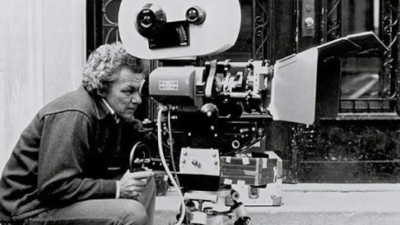
Gordon Willis
Gordon Willis
Interestingly, the lasting visual imprint of a Gordon Willis film seems to exist in the 1970s in American cinema. In style and construct, he defined the look and feel of an era. As Francis Ford Coppola, Woody Allen, and Alan J. Pakula patented themselves as the decade’s break out directors, Willis tirelessly absorbed and translated their concepts into complex and contrasting tableaux’s, wedding light and darkness in tilting matrimony.
A New York City native and a make-up artist’s son, Willis learned the industry early and was fluent in stage design from a young age. Time spent with the US Air force sharpened his appetite and honed his skill as he turned out war films for the motion picture unit. Like Wexler, he re-invented the industry technique learned early on in his career. Built upon a solid foundation of trial and error, standard practice, and copious experience, his methodology was a stripped down, bare bones type of operation. Simply, Willis maintained a visual foresight geared toward his audience and how they would digest the story. At its core, it was about taking his audience from point A to point B then C and then so forth, with upmost efficiency. Shots were made to be cut. The camera, its lens and proximity, its angle, its movement in relation to characters, and further, their movement hinged upon the eventual connectivity of one shot to another. This tidy procedure bred flawless consistency, and this was essentially his flare. Every shot is succinct because it is always battened down by the overall look and feel of the story as a whole.
"Klute (1971)"
The precise arrangement of every shot re-iterated Willis’ clear and yet profound mandate to “represent” reality as opposed to re-creating it. In this way, light and dark, camera angle, etc. come to embody and ultimately illuminate the sweeping themes of his films. His penchant for sharp juxtaposition between cuts and intense contrast within frames yielded some of the most provocative scenes in American cinema. Dubbed the “Master of Shadows,” he modestly owed his acclaim to simplicity and acquired confidence of practice.
Willis’ 1971 crime thriller Klute centers on Bree (Jane Fonda) a New York call girl. The subject of John Klute’s (Donald Sutherland) missing person’s investigation, she occupies the majority of our attention on and off screen, a feature of Fonda’s magnetism in general. The two maintain a restrained chemistry, coming together in an awkward symbiosis in order to find answers and protection. Steeped in era specific regalia, Alan J Pakula points demandingly toward the glaring discourses of women’s liberation, prostitution, and anti-Vietnam war sentiment. Enhancing these themes of course is Willis’ meditative lens, patiently surveilling our main characters as they negotiate control and comfort. It is also an example of Willis’ strict but effective geometry, tight interiors and likewise slowly constrictive shots personify the danger stalking forever just outside of frame.
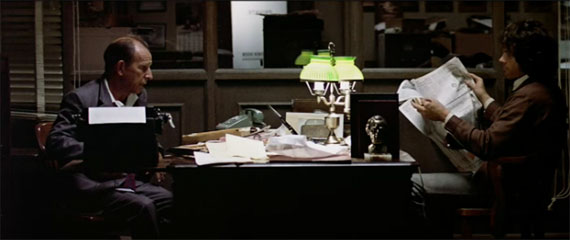
"The Parallax View (1974)"
Willis again carefully dissects the screen, relegating action to miniscule but sterilely lit portions of his frame. These highly dichotomous compositions lead us to the most literal and significant interpretations, something he has mastered and recurrently exercises for maximal impact. Joseph Frady (Warren Beatty) a journalist on the run divulges classified and dangerous information to his editor Bill Rintels (Hume Cronyn) in his tiny glass office, a vivarium floating in a dark newspaper room. Frady, who has penetrated an elite assassin’s recruitment facility, follows them into the shadows where they carry out their orders robotically. Their world is opaque and all consuming; likewise, Willis’s darkness gradually strangles the light into submission. The second of three collaborations between himself and Alan J Pakula, The Parallax View (1974) synthesizes the most politically subversive themes with finely tuned formal delivery. A collective suspicion stemming from the highly investigated and even more so theorized JFK assassination, humors Pakula’s critique of a lone patsy narrative.
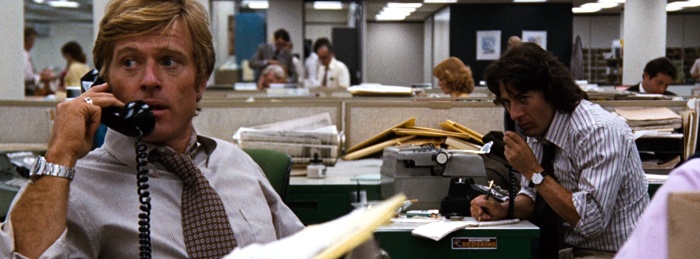
"All the President's Men (1976)"
In 1976, the two tackled the story of Carl Bernstein and Bob Woodward, two Washington Post journalists responsible for breaking news of the Watergate scandal. A mix of newsreels, newspaper headlines, and pre-recorded voice-over cumulate as the two reporters dig deeper and deeper into Nixon’s conflicting presidential campaign. Themes formalize into visual flares, illuminating scenes and sentiments of our main characters. A dim parking garage quickly becomes a busy and sterile newsroom as “Deep throat’s” clues make their way into the light of day; likewise, a spiraling camera emulates the abyss of information as Woodward and Bernstein sift through names in the congressional library. Again, this is Willis’ way of thickening the narrative; a perfect example of his timeless dexterity.
Note: The SIX films as part of the Calgary Cinematheque’s Spotlight: Wexler & Willis Series are:
Who's Afraid of Virginia Woolf?: Jan 11 at the Globe Cinema
In the Heat of the Night: Jan 18 at the Plaza Theatre
Medium Cool: Feb 1 at the Globe Cinema
Klute: Feb 15 at the Plaza Theatre
The Parallax View: Mar 1 at the Globe Cinema
All the President's Men: Mar 8 at the Plaza Theatre
References
Anderson, John. "Gordon Willis, 'Godfather' Cinematographer, Dies at 82." The New York Times. May 19, 2014. Accessed October 27, 2017. https://www.nytimes.com/2014/05/20/movies/gordon-willis-godfather-cinematographer-dies-at-82.html.
Anderson, John. "Haskell Wexler, Oscar-Winning Cinematographer, Dies at 93." The New York Times. December 27, 2015. Accessed October 27, 2017. https://www.nytimes.com/2015/12/28/movies/haskell-wexler-oscar-winning-cinematographer-dies-at-93.html. Bergan, Ronald. "Haskell Wexler obituary." The Guardian. December 27, 2015. Accessed October 27, 2017. https://www.theguardian.com/film/2015/dec/27/haskell-wexler
Bergan, Ronald. "Gordon Willis obituary." The Guardian. May 19, 2014. Accessed October 27, 2017. https://www.theguardian.com/film/2014/may/19/gordon-willis.Ebert, Roger. "Medium Cool Movie Review & Film Summary (1969) | Roger Ebert." RogerEbert.com. September 21, 1969. Accessed October 27, 2017. http://www.rogerebert.com/reviews/medium-cool-1969.
Cox, Alex. "The Parallax View: a JFK conspiracy film that gets it right." The Guardian. November 19, 2013. Accessed October 27, 2017. https://www.theguardian.com/film/filmblog/2013/nov/19/the-parallax-view-kennedy-assassination.
Dircks, Tim."The greatest films The "Greatest" and the "Best" in Cinematic History www.filmsite.org." An award-winning, unique resource of film reference material for film buffs and others, with reviews of classic American-Hollywood films, Academy Awards history, film posters. Accessed October 27, 2017. http://www.filmsite.org/.
Ebert, Roger. "All the President's Men Movie Review (1976) | Roger Ebert." RogerEbert.com. January 01, 1976. Accessed October 27, 2017. http://www.rogerebert.com/reviews/all-the-presidents-men-1976.
Ebert, Roger. "Klute Movie Review & Film Summary (1971) | Roger Ebert." RogerEbert.com. January 01, 1971. Accessed October 27, 2017. http://www.rogerebert.com/reviews/klute-1971.
French, Philip. "Medium Cool review – a landmark fusion of fiction and documentary." The Guardian. September 13, 2015. Accessed October 27, 2017. https://www.theguardian.com/film/2015/sep/13/medium-cool-dvd-review-haskell-wexler-philip-french.
Hogg, Trevor "Daring Ideas: Haskell Wexler talks about In the Heat of the Night & Medium Cool." Flickering Myth. September 12, 2012. Accessed October 27, 2017. https://www.flickeringmyth.com/2012/09/daring-ideas-haskell-wexler-talks-about/.
McLellan, Dennis, and Jack Dolan. "Haskell Wexler dies at 93; two-time Oscar-winning cinematographer and lifelong activist." Los Angeles Times. December 27, 2015. Accessed October 27, 2017. http://www.latimes.com/entertainment/movies/la-me-ln-haskell-wexler-93-obituary-20151227-story.html
Sylbert, Richard, and Sylvia Townsend. Designing movies: portrait of a Hollywood artist. Westport, CT: Praeger, 2006.
-END-
Whitepaper re-posted with permission originally from Calgary Cinematheque: Spotlight: Willis & Wexler >
Calgary Local Scene Screenings:
CC: Who's Afraid of Virginia Woolf?: Jan 11 at the Globe Cinema
CC: In the Heat of the Night: Jan 18 at the Plaza Theatre
CC: Medium Cool: Feb 1 at the Globe Cinema
CC: Klute: Feb 15 at the Plaza Theatre
CC: The Parallax View: Mar 1 at the Globe Cinema
CC: All the President's Men: Mar 8 at the Plaza Theatre
NOTE: The showtimes listed on CalgaryMovies.com come directly from the theatres' announced schedules, which are distributed to us on a weekly basis. All showtimes are subject to change without notice or recourse to CalgaryMovies.com.
